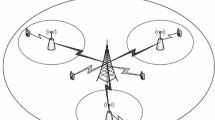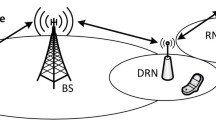Abstract
This paper proposes an energy-efficient position of relay node (RN) for a cooperative single amplify-and-forward relay. The optimum position of RN based on a single carrier-frequency division multiple access of LTE-A network is proposed. The proposed scheme models load balance to maximize energy efficiency (EE) for multiple users. Two categories of users (UEs) are considered; guaranteed bit rate (GBR) and non-guaranteed bit rate. The optimal position of RN is achieved to maximize the average EE for single-relay and total EE by satisfying all UEs. Additionally, the load distribution index in the cell is calculated when multiple RNs are considered. The simulation results have demonstrated that the proposed GBR achieves the objective value in terms of total and average EE by balancing load. Therefore, it is concluded that the optimum position of RN is at 74.5% of the cell radius.
























Similar content being viewed by others
References
Han, B., Peng, M., Jia, Y., & Wang, W. (2015). Optimal resource allocation for multiple network-coded two-way relay in orthogonal frequency division multiplexing systems. Wireless Communications and Mobile Computing, 15, 30–42.
Rizk, R., Magdy, S. M., & Zaki, F. W. (2015). Energy efficiency of virtual multi-input, multi-output based on sensor selection in wireless sensor networks. Wireless Communications and Mobile Computing, 15(1), 1–15.
Abo Hashish, S. M. M., Rizk, R. Y., & Zaki, F. W. (2018). Joint energy and spectral efficient power allocation for Long Term Evolution-Advanced. Computers and Electrical Engineering, 72, 828–845.
Rabie, K. M., Adebisi, B., & Alouini, M. S. (2017). Half-duplex and full-duplex AF and DF relaying with energy-harvesting in log-normal fading. IEEE Transactions on Green Communications and Networking, 1(4), 468–480.
Genc, V., Murphy, S., & Murphy, J. (2008) Performance analysis of transparent relays in 802.16j MMR networks. In Proceedings of 6th international symposium on modeling and optimization in mobile, Ad Hoc, and wireless networks and workshops (WiOPT) (pp. 273–281), Berlin.
Han, L., Mu, J., Liu, S., Zhang, Z. (2015) Optimization of power allocation and relay location for decode-and-forward relaying in the presence of co-channel interference. In Proceedings of the third international conference on communications, signal processing, and systems (pp. 319–327).
Han, L., Mu, J., Wang, W., & Zhang B. (2014) Optimization of relay placement and power allocation for decode-and-forward cooperative relaying over correlated shadowed fading channels. EURASIP Journal on Wireless Communications and Networking, 1, 1–7.
Gaafar, M., Khafagy, M. G., Amin, O., Schaefer, R. F., & Alouini, M. S. (2017). Full-duplex relaying with improper Gaussian signaling over Nakagami-m fading channels. IEEE Transactions on Communications, 99, 1–15.
Do, T. P., Song, I., & Kim, Y. H. (2013). Optimization of power allocation and relay position in multi-hop relay networks over generalized fading channels. IEEE Transactions on Vehicular Technology, 64(11), 5031–5041.
Carrión, R., Gómez, R., Camacho, J., & Teodoro, P. (2016). Optimal relay placement in multi-hop wireless networks. Ad Hoc Network, 46, 23–36.
Chattopadhyay, A., Sinha, A., Coupechoux, M., Kumar, A. (2013) Optimal capacity relay node placement in a multi-hop wireless network on a line. In Proceedings of 10th international symposium on modeling and optimization in mobile, Ad Hoc and wireless networks and workshops (WiOPT) (pp. 1–22), Paderborn, Germany.
Vasishta, A., Gzara, F., Ho, P. H., & Lin, B. (2015). Optimal location planning of relay-based next generation wireless access networks. Journal of Mobile Communication, Computation and Information, 22, 2159–2172.
Hamdi, A., El-Khamy, M., & El-Sharkawy, M. (2012) Optimized dual relay deployment for LTE-Advanced cellular systems. In Proceedings of IEEE conference wireless communications and networking conference (WCNC) (pp. 2869–2873), Paris, France.
Martins, A., Rodrigues, A., & Vieira, P. (2014). On the choice of positioning and cluster size for fixed relay stations in a LTE network. Wireless Personal Communications, 79, 745–762.
Martins, A., Vieira, P., & Rodrigues, A. (2013). On the Optimization of deployed positions for fixed relay stations in a LTE cooperative network. Proceedings of conference on electronics, telecommunications and computers (CETC), 17, 90–98.
Lateef, H.Y., Chiasserini, C.F., ElBatt, T., Mohamed, A., & Guizani, M. (2014) Towards energy efficient relay placement and load balancing in future wireless networks. In Proceedings of IEEE 25th annual international symposium on personal, indoor, and mobile radio communication (PIMRC), Washington, D.C. (USA).
Abdelhay, E. H., Zaki, F. W., Kishk, S. S., & Moustafa, H. S. (2015). Uplink LTE-A performance improvement using synchronous direct and multi-hop transmission. Digital Technologies, 1(1), 43–51.
Abo Hashish, S.M.M., Rizk, R.Y., & Zaki, F.W. (2015) Optimal multi-relay placement for LTE-A. In Proceedings of international computer engineering conference (ICENCO) (pp. 195–201), Cairo.
Narayanan, K., & Shafeek, B. (2014) Performance analysis of cooperative OFDM system. In Proceedings of international conference on signal processing, embedded system and communication technologies and their applications for sustainable and renewable energy (ICSECSRE) 3(3), Tamil Nadu, India.
Wang, Y.C., & Hsieh, S.Y., (2015) QoS-provisioning downlink resource management in 4G cellular systems. In Proceedings of international wireless communications and mobile computing (IWCMC) conference, Dubrovnik, Croatia.
Corroy, S., Falconetti, L., & Mathar, R. (2012) Cell association in small heterogeneous: Networks downlink sum rate and min rate maximization. In Proceedings of IEEE wireless communications and networking conference: PHY and fundamentals (pp. 2485–2489), Shanghai, China.
Rangisetti, A. K., Pasca, T. V., & Tamma, B. R. (2017). QoS Aware load balance in software defined LTE networks. Computer Communications, 97, 52–71.
Obi, E., Garba, S., Sani, S. M. (2015) Development of an energy estimation algorithm for LTE mobile access networks. International Journal of Engineering Research and Technology (IJERT) 4(7), 313–317.
Author information
Authors and Affiliations
Corresponding author
Additional information
Publisher's Note
Springer Nature remains neutral with regard to jurisdictional claims in published maps and institutional affiliations.
Rights and permissions
About this article
Cite this article
AboHashish, S.M.M., Rizk, R.Y. & Zaki, F.W. Energy Efficiency Optimization for Relay Deployment in Multi-User LTE-Advanced Networks. Wireless Pers Commun 108, 297–323 (2019). https://doi.org/10.1007/s11277-019-06404-z
Published:
Issue Date:
DOI: https://doi.org/10.1007/s11277-019-06404-z




